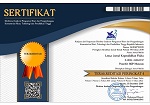Pengukuran Tingkat Kemampuan Berpikir Siswa SMA Kabupaten Sumba Barat Daya Berdasarkan Taksonomi Bloom Revisi
DOI:
https://doi.org/10.33394/j-lkf.v9i2.4687Keywords:
Physics, Thinking Skills, partial credit model, Bloom's TaxonomyAbstract
Penelitian ini bertujuan untuk mengukur tingkat kemampuan berpikir siswa SMA di Kabupaten Sumba Barat Daya pada mata pelajaran fisika. Jenis penelitian ini adalah penelitian deskriptif kuantitatif. Sampel penelitian terdiri dari 220 siswa dari 6 sekolah yang berbeda. Metode pengumpulan data yang digunakan dalam penelitian ini adalah metode tes melalui pemberian soal pilihan ganda beralasan. Teknik penilaian yang digunakan adalah teknik penilaian polytomous empat kategori dengan mengikuti model kredit parsial (PCM). Instrumen soal yang digunakan adalah instrumen kemampuan berpikir tingkat tinggi (HOTS). Hasil penelitian menunjukkan bahwa tingkat kemampuan berpikir berada pada kategori kurang dari empat kategori yang ditetapkan yaitu sangat baik, baik, cukup, dan kurang.
Measurement of Thinking Ability Level of Southwest Sumba High School Students Based on Revised Bloom's Taxonomy
Abstract
This study aims to measure the level of thinking ability of high school students in Southwest Sumba Regency on physics subjects. This type of research is descriptive quantitative research. The research sample consisted of 220 students from 6 different schools. The data collection method used in this study is a test method through the provision of reasoned multiple-choice questions. The assessment technique used is a four-category polytomous assessment technique by following the partial credit model (PCM). The question instrument used is the higher-order thinking ability (HOTS) instrument. The results showed that the level of thinking ability was in the category of less than the four defined categories, namely very good, good, sufficient, and poor.
References
Anderson, & Krathwohl. (2010). Kerangka Landasan Untuk Pembelajaran, Pengajaran, dan Asesmen. Yogyakarta: Pustaka Pelajar.
Istiyono, E., Mardapi, D., & Suparno. (2015). Effectiveness of reasoned objective choice test to measure higher order thinking skills in physics implementing of curiculum 2013. International Conference on Education Research and Evaluation.
Lewy, Zulkardi, & Aisyah. (2099). Pengembangan Soal Untuk Mengukur Kemampuan Berpikir Tingkat Tinggi Pokok Bahasan Barisan dan Deret Bilangan di Kelas IX Akselerasi SMP Xaverius Maria Palembang. Jurnal Pendidikan Matematika Universitas Sriwijaya.
Mardapi, D. (2008). Teknik Penyusunan Instrumen Tes dan Nontes. Yogyakarta: Mitra Cendekia Offset.
Mundilarto. (2010). Penilaian Hasil belajar Fisika. Yoyakarta:: Pusat Pengembangan Instruksional Sains (P2IS) FMIPA-Universitas Negeri Yogyakarta.
Musrikah, M. (2018). Higher Order Thingking Skill (Hots) Untuk Anak Sekolah Dasar Dalam Pembelajaran Matematika. Martabat:. Jurnal Perempuan Dan Anak., 339-360.
PUSKURBUK. (2013). Kurikulum 2013 Pedoman Guru Mata Pelajaran FISIKA Untuk Sekolah Menengah Atas (SMA)/ Madrasah Aliyah (MA). Jakarta.: Pusat Kurikulum Dan Perbukuan Badan Penelitian Dan Pengembangan Kementerian Pendidikan Dan Kebudayaan.
Putri, Istiyono, & Nurcahyanto. (2016). Pengembangan Instrumen Tes Keterampilan Berpikir Kritis Dalam Bentuk Pilihan Ganda Beralasan (Politomus) Di DIY. Unnes Physics Education Journal, 76-84.
Rizki, A., & Fadhilaturrahmi. (2017). Evaluasi Pembelajaran IPS Berbasis Taksonomi Bloom Dua Dimensi di Sekolah Dasar. Jurnal Basicedu, 12-21.
Rosidah, N. A., Ramalis, T. R., & Suyana, I. (2018). Karakteristik Tes Keterampilan Berpikir Kritis (KBK) Berdasarkan Pendekatan Teori Respon Butir. Jurnal Inovasi Dan Pembelajaran Fisika, 54-63.
Sarjono. (2016). Pengembangan Soal Fisika Sma/Ma Politomus Berbasis Taksonomi Bloom Revisi. Jurnal Madaniyah, 1-16.
Septikasari, & Frasandy. (2018). Keterampilan 4c Abad 21 Dalam Pembelajaran Pendidikan Dasar. Jurnal Tarbiyah Al-Awlad, 112-122.
Sudijono, A. (2012). Pengantar Statistik Pendidikan. Jakarta: PT. Raja Grafindo Persada.
Suluh, M. (2013). Suluh, Melkianus (2013). Studi Keterlaksanaan Pembelajaran Fisika Berbasis Scientific Approach di SMA Kota Yogyakarta. Thesis. Yogyakarta: Universitas Negeri Yogyakarta.
Sumintono, B., & Widhiarso. (2014). Sumintono dan Widhiarso. (2014). Aplikasi Model Rasch Untuk Penelitian Ilmu-Ilmu Sosial. Cimahi.: Trim Komunikata Publishing House.
Yulianti. (2017). Pengembangan Alat Evaluasi Hasil Belajar Mata Pelajaran Pendidikan Agama Islam Berbasis Taksonomi Bloom Dua Dimensi. Journal of Islamic Education Studies, 407-430.
Downloads
Published
How to Cite
Issue
Section
License
Authors who publish with Lensa: Jurnal Kependidikan Fisika agree to the following terms:
- For all articles published in Lensa: Jurnal Kependidikan Fisika, copyright is retained by the authors. Authors give permission to the publisher to announce the work with conditions. When the manuscript is accepted for publication, the authors agree to automatic transfer of the publishing right to the publisher.
- Authors retain copyright and grant the journal right of first publication with the work simultaneously licensed under a Creative Commons Attribution-ShareAlike 4.0 International License that allows others to share the work with an acknowledgment of the work's authorship and initial publication in this journal.
- Authors are able to enter into separate, additional contractual arrangements for the non-exclusive distribution of the journal's published version of the work (e.g., post it to an institutional repository or publish it in a book), with an acknowledgment of its initial publication in this journal.
- Authors are permitted and encouraged to post their work online (e.g., in institutional repositories or on their website) prior to and during the submission process, as it can lead to productive exchanges, as well as earlier and greater citation of published work (See The Effect of Open Access).

This work is licensed under a Creative Commons Attribution-ShareAlike 4.0 International License.



